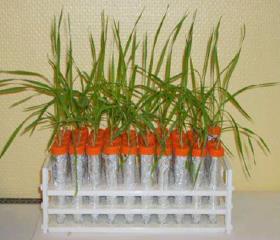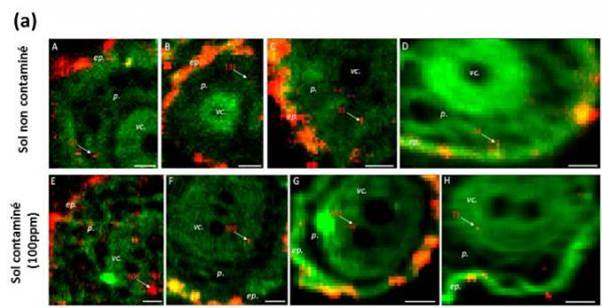With the exponential development of nanotechnologies, nanomaterials are likely to be disseminated in the environment. Moreover, plants are sensitive components of ecosystems, as they form a close link between the three ecosystems of water, soil and air, and are at the base of the food chain.
It is therefore essential to assess the impact of nanoparticles (NPs) on plants. What happens to NPs released into the environment? Are they captured and transferred by plants? And if so, could traces of NPs be found in our food, for example in our bread? To answer these questions, researchers have combined their skills to locate TiO2 nanoparticles in plants, and more specifically in wheat seedlings. In particular, it was possible to precisely measure the titanium present in wheat roots using the NIMBE* nuclear microprobe.

NPs are emerging pollutants whose concentration is increasing in soils due to their growing use in many everyday commercial products (cosmetics, foodstuffs, paints, etc.). In vitro studies have shown the toxicity of NPs to microorganisms, but there is still little data on their ecotoxicity and the fate of these contaminants in soils. TiO2 nanoparticles are among the three most widely produced nanomaterials (worldwide production of 2 million tonnes/year, AFSSET 2010 data). The building sector is one of the main areas where TiO2 NPs are used, notably in paints. This is why researchers have been investigating the impact of TiO2 NPs on wheat root growth. The present study, published in Science of the Total Environment, focuses on the root transfer of TiO2 NPs as a function of soil type. The challenge was to detect extremely low concentrations of NPs. Indeed, the concentration level to be studied had to be close to the concentrations found in nature (typically 100-500 ppm of NPs), the highest concentration being found in agricultural soils, following the spreading of sewage sludge, which concentrates NPs.
Wheat seeds were grown in different types of soil, either natural or exposed to concentrations of 100 ppm TiO2 NPs. Studies on the retention capacity of soils have shown that Ti content in soils not artificially loaded with NPs can vary greatly (by a factor of 40). In the face of NP contamination in the soils tested, two behaviors emerge: sand and silty sand do not retain titanium, while sandy and clay loams (soils composed of 40-60% sand, 30-50% silt and 15-25% clay, depending on their nature) will become enriched with titanium.
Cultivated wheat samples were analyzed by spectro-microscopy on the LUCIA line (µ-XRF), in order to locate TiO2 inside the roots and observe its pathway during root impregnation. On all maps (contaminated or uncontaminated soil), titanium is mainly detected adsorbed on the epidermis, and in lesser quantities in the parenchyma (water-transporting cells) and the central cylinder of roots, with no preferential distribution. As these µ-XRF observations were not quantitative, the absolute concentrations of calcium and titanium were estimated using the NIMBE nuclear microprobe, combining the µ-PIXE (Particle Induced X-ray Emission) and µ-RBS (Rutherford Backscattering Spectrometry) techniques
A significant transfer (Tifeuille/Tisol ratio = 60%) of nanoparticles to leaves was mainly measured for sand, which is by nature little used in agriculture, and no phytotoxicity was noted in this case. Intermediate, silty sand, with a titanium concentration in leaves 5 to 10 times lower than that induced by sand, could potentially present a risk to food safety, but these poor soils are not suitable for agriculture. In contrast, potting soils accumulate nanoparticles without any significant transfer to plants. The TiO2 NPs will then remain in the soil, with possible implications for the micro and macro-organisms present there, which now need to be studied.

References:
“Influence of soil type on TiO2 nanoparticle fate in an agro-ecosystem”
C. Larue, C. Baratange, D. Vantelon, H. Khodja, S. Surblé, A. Elger, M. Carrière, Science of the Total Environment 630, 609 (2018).
* The nuclear microprobe of UMR NIMBE’s LEEL team is accessible by experiment request, possible at any time during the year.
Contacts CEA-IRAMIS :
- Hicham Khodja, IRAMIS/NIMBE- Laboratoire d’Etude des Eléments Légers (LEEL)
- Suzy Surblé, IRAMIS/NIMBE – Laboratoire d’Etude des Eléments Légers (LEEL)
Collaboration :
- ECOLAB Laboratoire écologie fonctionnelle et environnement, CNRS, Université de Toulouse,
- CIBEST Chemistry Interface Biology for the Environment, Health and Toxicology, Grenoble Alpes University
- Laboratoire d’Étude d’Éléments Légers UMR 3685 NIMBE CEA-CNRS, Université Paris-Saclay,
- Synchrotron SOLEIL, Lucia light line, Gif-Sur-Yvette, France




